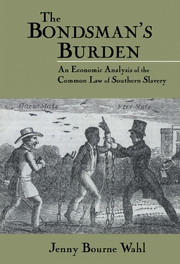Book contents
- Frontmatter
- Contents
- Acknowledgments
- 1 American Slavery and the Path of the Law
- 2 The Law of Sales: Slaves, Animals, and Commodities
- 3 The Law of Hiring and Employment: Slaves, Animals, and Free Persons
- 4 The Law Regarding Common Carriers: Slaves, Animals, Commodities, and Free Persons
- 5 The Law Regarding Governments, Government Officials, Slave Patrollers, and Overseers: Protecting Private Property versus Keeping Public Peace
- 6 The Legal Rights and Responsibilities of Strangers Toward Slaves, Animals, and Free Persons
- 7 Treatment of One's Slaves, Servants, Animals, and Relatives: Legal Boundaries and the Problem of Social Cost
- 8 The South's Law of Slavery: Reflecting the Felt Necessities of the Time
- Notes
- Index
8 - The South's Law of Slavery: Reflecting the Felt Necessities of the Time
Published online by Cambridge University Press: 24 October 2009
- Frontmatter
- Contents
- Acknowledgments
- 1 American Slavery and the Path of the Law
- 2 The Law of Sales: Slaves, Animals, and Commodities
- 3 The Law of Hiring and Employment: Slaves, Animals, and Free Persons
- 4 The Law Regarding Common Carriers: Slaves, Animals, Commodities, and Free Persons
- 5 The Law Regarding Governments, Government Officials, Slave Patrollers, and Overseers: Protecting Private Property versus Keeping Public Peace
- 6 The Legal Rights and Responsibilities of Strangers Toward Slaves, Animals, and Free Persons
- 7 Treatment of One's Slaves, Servants, Animals, and Relatives: Legal Boundaries and the Problem of Social Cost
- 8 The South's Law of Slavery: Reflecting the Felt Necessities of the Time
- Notes
- Index
Summary
The felt necessities of the time, the prevalent moral and political theories, intuitions of public policy, evolved or unconscious, even the prejudices which judges share with their fellow-men … [determine] the rules by which men should be governed. The law embodies the story of a nation's development through many centuries. … In order to know what it is, we must know what it has been, and what it tends to become.
– Oliver W. Holmes, Jr.[The slave] is made after the image of the Creator. He has mental capacities, and an immortal principle in his nature, that constitute him equal to his owner, but for the accidental position in which fortune has placed him.
– Ford v. Ford, 7 Humph. 92, 95 (Tn. 1846)To Southern judges, was a slave property or a human being made after the image of the Creator? For many disputes, the judiciary considered the slave virtually the same as a valuable steed. But slaves, unlike their equine counterparts, possessed reason and imagination. Of all living property, the slave alone could mimic the master. Consequently, a slave often was equal to his owner in donning the mantle of the reasonable person, even though fortune – or, more accurately, misfortune – had cast him in the role of property. In recognizing the twofold nature of the slave, antebellum judges balanced the property interests of the master against the wider interests of Southern society. The result was a set of legal rules that tended to be efficient, at least within its peculiar context.
- Type
- Chapter
- Information
- The Bondsman's BurdenAn Economic Analysis of the Common Law of Southern Slavery, pp. 174 - 178Publisher: Cambridge University PressPrint publication year: 1997

